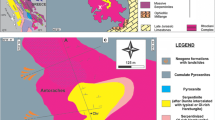Abstract
We present a detailed mineralogical, petrological and melt inclusion study of unusually fresh, primitive olivine + clinopyroxene phyric Lower Pillow Lavas (LPL) found near Analiondas village in the northeastern part of the Troodos ophiolite (Cyprus). Olivine phenocrysts in these primitive LPL show a wide compositional range (Fo82–92) and have higher CaO contents than those from the Upper Pillow Lavas (UPL). Cr-spinel inclusions in olivine are significantly less Cr-rich (Cr/Cr + Al = 28–67 mol%) compared to those from the UPL (Cr# = 70–80). These features reflect differences in melt compositions between primitive LPL and the UPL, namely higher CaO and Al2O3 and lower FeO* compared to the UPL at a given MgO. LPL parental melts (in equilibrium with Fo92) had ∼10.5 wt% MgO and crystallization temperatures ∼1210 °C, which are significantly lower than those previously published for the UPL (14–15 wt% MgO and ∼1300 °C for Fo92). The fractionation path of LPL parental melts is also different from that of the UPL. It is characterized initially by olivine + clinopyroxene cotectic crystallization joined by plagioclase at ∼9 wt% MgO, whereas UPL parental melts experienced a substantial interval of olivine-only crystallization. Primitive LPL melts were formed from a mantle source which was more fertile than that of tholeiites from well-developed intra-oceanic arcs, but broadly similar in its fertility to that of Mid-Ocean Ridge Basalt (MORB) and Back Arc Basin Basalts (BABB). The higher degrees of melting during formation of the LPL primary melts compared to average MORB were caused by the presence of subduction-related components (H2O). Our new data on the LPL coupled with existing data for the UPL support the existing idea that the LPL and UPL primary melts originated from distinct mantle sources, which cannot be related by progressive source depletion. Temperature differences between these sources (∼150 °C), their position in the mantle (∼10 kbar for the colder LPL source vs 15–18 kbar for the UPL source), and temporal succession of Troodos volcanism, all cannot be reconciled in the framework of existing models of mantle wedge processes, thermal structure and evolution, if a single mantle source is invoked. Possible tectonic settings for the origin of the Troodos ophiolite (forearc regions of intra-oceanic island arc, propagation of backarc spreading into arc lithosphere) are discussed.
Similar content being viewed by others
Author information
Authors and Affiliations
Additional information
Received: 20 May 1996 / Accepted: 25 March 1997
Rights and permissions
About this article
Cite this article
Portnyagin, M., Danyushevsky, L. & Kamenetsky, V. Coexistence of two distinct mantle sources during formation of ophiolites: a case study of primitive pillow-lavas from the lowest part of the volcanic section of the Troodos Ophiolite, Cyprus. Contrib Mineral Petrol 128, 287–301 (1997). https://doi.org/10.1007/s004100050309
Issue Date:
DOI: https://doi.org/10.1007/s004100050309




